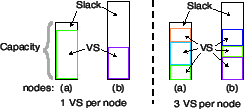Next: Proportion Up: Prior Load Balancing Techniques Previous: Prior Load Balancing Techniques
The simplest load balancing technique we discuss is log(N) VS. It balances node namespaces and does not permit arbitrary IDs. It was first introduced by Karger et al. [25].
The log(N) VS load balancing algorithm follows from the
observation that randomly chosen node IDs do not uniformly cover the
identifier space. In fact, the distribution of namespaces is
roughly Poisson, with the largest being ![]() times the
average.
times the
average.
log(N) VS is predicated on the assumptions that workload and
capacity are uniform. When these assumptions hold, if each node has a
single VS, those few nodes at the tail become bottlenecks. By the
Central Limit Theorem, the more VSs each node makes, the more normal
(and balanced) the average (total) namespace of each node becomes.
Because there are drawbacks to having too many VSs, this algorithm
suggests that each node having ![]() VS reaches a good compromise.
All nodes then have average load within a constant factor. An
illustration of this is shown in Figure 4. This
technique is non-reactive: it makes no attempt to rebalance load after
a node joins.
VS reaches a good compromise.
All nodes then have average load within a constant factor. An
illustration of this is shown in Figure 4. This
technique is non-reactive: it makes no attempt to rebalance load after
a node joins.

|
This algorithm works well for the case when its assumptions on
capacities and workload distribution hold. However, increasing the
number of VSs causes a few problems. First, it increases churn
because when one node departs, it must take its ![]() VSs with
it, causing
VSs with
it, causing ![]() times more adjustments to be made. Second, each
node must hold
times more adjustments to be made. Second, each
node must hold ![]() times as much routing state. Finally,
because there are more VSs in the system, the number of hops per
lookup (and latencies) increases. Proposals have been made to
mitigate the last two problems, but they have not been
evaluated [12].
times as much routing state. Finally,
because there are more VSs in the system, the number of hops per
lookup (and latencies) increases. Proposals have been made to
mitigate the last two problems, but they have not been
evaluated [12].
Because several improvements to this basic namespace balancing concept have been proposed (see Section VII), the log(N) VS algorithm provides a baseline to suggest how this type of algorithm can be expected to perform under conditions of heterogeneity and skew in particular.
Jonathan Ledlie 2006-01-06